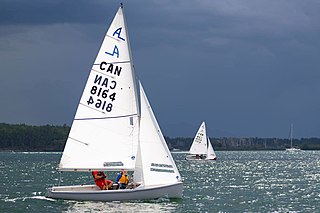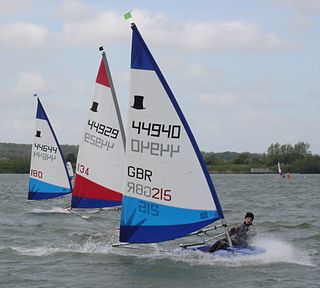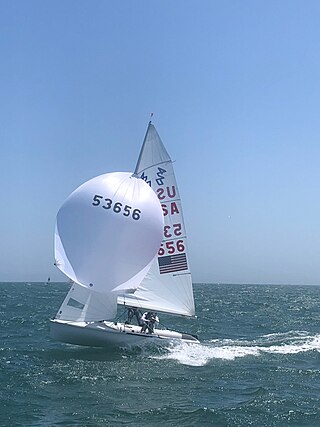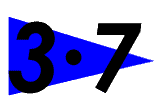
Dinghy sailing is the activity of sailing small boats by using five essential controls:
The Mirror is a type of popular sailing dinghy with more than 70,000 built.

Dinghy racing is a competitive sport using dinghies, which are small boats which may be rowboats, have an outboard motor, or be sailing dinghies. Dinghy racing has affected aspects of the modern sailing dinghy, including hull design, sail materials and sailplan, and techniques such as planing and trapezing.

The Albacore is a 4.57 m (15 ft) two-person planing dinghy with fractional sloop rig, for competitive racing and lake and near-inshore day sailing. Hulls are made of either wood or fiberglass. The basic shape was developed in 1954 from an Uffa Fox design, the Swordfish. Recent boats retain the same classic dimensions, and use modern materials and modern control systems.

The Topper is an 11 foot 43 kg (95 lb) sailing dinghy designed by Ian Proctor. The Topper was a one-design boat until 2023 when a new version was produced, and is sailed mostly around the British Isles. It was recognised as a World Sailing Class. The boat previously constructed from polypropylene, and now roto moulded, is popular as a racing boat or for sail training. The class association (ITCA) organise racing events, which range from small travellers to major championships. The RYA run squads alongside the events; in these squads young sailors who are given specialist race coaching. It is sailed widely among junior sailors in the UK and Ireland and there is a growing fleet in China.

The Laser is a class of single-handed, one-design sailing dinghies using a common hull design with three interchangeable rigs of different sail areas, appropriate to a given combination of wind strength and crew weight. Ian Bruce and Bruce Kirby designed the Laser in 1970 with an emphasis on simplicity and performance.

The International 420 Dinghy is a sailing dinghy popular for racing and teaching. The hull is fiberglass with internal buoyancy tanks. The 420 has a bermuda rig, spinnaker and trapeze. It has a large sail-area-to-weight ratio, and is designed to plane easily. The 420 is an International class recognised by World Sailing. The name refers to the boat's length of 420 centimetres.

The Cadet is a class of sailing dinghy designed to be sailed by two children up to the age of 17. It is a one-design class, originally designed by Jack Holt in 1947. Cadets are sailed worldwide in more than 40 countries.

The Fireball is a British sailing dinghy that was designed by Peter Milne as a one-design racer and first built in 1962.

The RS300 is a modern racing sailing dinghy made by RS Sailing. The RS300 is a one-design, single-handed, hiking dinghy with a PY of 972. Designed by Clive Everest and first produced in 1998, it is inspired by the International Moth, of which Everest was a successful designer.
The P-Class is a type of small single sail dinghy, popular as a training boat for young people in New Zealand. This class is famous for being the sailing trainer vessel for many new entrants into the sport, and virtually every famous New Zealand yachtsman, including Dean Barker and Russell Coutts, learnt to sail in one. The P-Class was for many years the most common sailing boat in New Zealand.

The RS Feva is a two-person sailing dinghy designed by Paul Handley in 2002. It is manufactured and distributed by RS Sailing. The RS Feva is an International Sailing Federation (ISAF) International Class, a Royal Yachting Association (RYA) Supported Junior Class, and has been selected by the Dansk Sejlunion and Norges Seilforbund for major sailing growth projects.

A sailing yacht, is a leisure craft that uses sails as its primary means of propulsion. A yacht may be a sail or power vessel used for pleasure, cruising, or racing. There is no standard definition, so the term applies here to sailing vessels that have a cabin with amenities that accommodate overnight use. To be termed a "yacht", as opposed to a "boat", such a vessel is likely to be at least 33 feet (10 m) in length and have been judged to have good aesthetic qualities. Sailboats that do not accommodate overnight use or are smaller than 30 feet (9.1 m) are not universally called yachts. Sailing yachts in excess of 130 feet (40 m) are generally considered to be superyachts.
The RS500 is a double handed trapeze skiff designed by Phil Morrison, manufactured and designed by RS Sailing. The class has a PY number of 972. There are two sail size options and makes the RS500 suitable for youngsters and adults. With ISAF Recognised Status, the RS500 has a racing circuit with events in the UK, Europe and the World Championships.

RS Sailing is an international designer, builder and supplier of sailboats and dinghies and associated goods and services supported by a worldwide dealer network and class associations.
The RS Quba is a one or two man monohull dinghy in the RS Sailing range of sailing boats. It is a popular boat for beginners.

The RS100, first launched in 2009 by RS Sailing, is a singlehanded skiff. Possessing an asymmetric spinnaker the boat has two PY numbers of 981 for the 10.2 rig and 1004 for the 8.4 rig. The RS100 has a racing event circuit in the United Kingdom and in Europe, with the Eurotour beginning in 2011.
The X1 is a fast, light-weight sailing dinghy designed for sailing on rivers, estuaries and inland waters by Phil Morrison. The dinghy is sailed by 2 or 3 people and has a main, a jib and a symmetric spinnaker. The boat is designed to be easily driven in very light wind, easy to sail and rig and quick to tack. It has a PY of 949. Currently the PY is the same as an RS400 but can perform better in light wind and slower in heavier winds.

The Farr 3.7 is a one-person sailing dinghy designed by Bruce Farr in 1971. The design plans are sold by the 3.7 Class Owners Association and they are built by a mix of professionals and home built by amateurs. The 3.7 Class is recognised by Yachting New Zealand as a national class and yachts are sailed in New Zealand, Australia and Great Britain. Full sets of plans have been sold worldwide to a number of individuals with greatest numbers in Germany, Japan, USA, South Korea, Poland, France, Belgium, Russia, Spain, Uruguay.

The Topper Topaz is a British single-handed or two-handed sailing dinghy that was designed as a beginner and intermediate racer.















